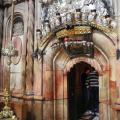CHURCH OF THE HOLY SEPULCHRE
The Holy Sepulchre, the main holy place of Christianity, is the centre of the Christian quarter. Since the 4th century, pilgrims have been praying in this church, built on the site of Calvary, exactly where Jesus "was nailed to the cross, died and rose again ".
In the past, this location was outside the city walls and was used as a place for executions. It was called Golgotha (from Aramaic Gulgoleth), which means "skull", on the one hand because its rounded shape resembled a skull, and on the other hand because legend has it that the place where Adam's skull was buried was located.
The construction of the first basilica of the Holy Sepulchre began in 326, on the orders of Emperor Constantine. It was built on the site of a 2nd century Roman temple and sanctuary which, according to local tradition, stood on the very place where Jesus was crucified and buried. When the Roman buildings were demolished, several tombs carved into the rock were discovered.
Not much remains today of the original Byzantine building, which was burned and looted by the Persians in 614, partially rebuilt, damaged by an earthquake in 808 and demolished again in 1009 on the orders of the Fatimid caliph el-Hakem. Some of it was rebuilt by the Byzantine Emperor Constantine Monomask in 1048, but most of the present building is the result of reconstruction by the Crusaders in the 12th century and subsequent renovations. With its successive additions, crypts and floors, the church is a real labyrinth.
Immediately at the entrance, one cannot miss the pink limestone slab, illuminated by 8 suspended lamps symbolizing the different Christian denominations. This is the Stone of Unction where, according to the Greek Orthodox, the body of Christ was descended from the cross. According to Roman Catholics, this is where he was anointed before being placed in the tomb. Around the slab, we will notice the many pilgrims who kiss it or pour oil on the stone and moisten a cloth as a sign of devotion.
The Holy Sepulchre includes the last 5 stations of the Way of the Cross (Via Dolorosa). As you enter the basilica, the staircase on your right will lead you to a chapel divided into 2 naves. The chapel on the left belongs to the Greek Orthodox, the one on the right to the Franciscans. At the entrance to the latter is the 10th station on the Via Dolorosa where Jesus was reportedly stripped of his clothes; you will notice the magnificent 17th century altar offered by the Medici family. Inside the same chapel you will see the 11th station, the place where Jesus would have been nailed to the Cross. The 12th station is located in the Greek Orthodox chapel and marks the death of Jesus on the Cross. Between stations XI and XII, there is station XIII where the body of Jesus was reportedly taken down from the cross and given to Mary.
Going down the stairs behind the Greek Orthodox chapel you will reach the ground floor. The earthquake that occurred at the time of Christ's death allegedly caused the crack, protected behind a window, that can be seen on the wall. Opposite you will also see a mosaic that allows you to follow, through the scenes represented, the path of Jesus' body, descended from the cross, perfumed with fragrant oils and placed in the tomb.
In the centre of the rotunda, under the dome, is the Holy Sepulchre , which preserves the tomb of Jesus. The aedicula is composed of 2 parts. The first is the Chapel of the Angel, in the centre of which is preserved a fragment of the rock on which the angel would have sat when the women went to the already empty tomb after Christ's resurrection. The second room is the actual burial chamber, which is also the last station of the Way of the Cross. Above the tomb, 43 silver lamps were hung: 13 belong to the Latins, 13 to the Greeks, 13 to the Armenians, while the Copts have only 4.
After a long phase of work, the new marble aedicula, rebuilt identically, was inaugurated in March 2017. This restoration allowed scientists to open for the first time in at least two centuries the place considered by Christians to be Jesus' tomb.
In front of the aedicula, you can see a church where a stone stands, considered as the navel of the world (Omphalos Mundi).
The Holy Sepulchre is divided among 6 Christian communities: Roman Catholics, Greek Orthodox, Armenians, Copts, Ethiopians, Syrians. Muslims, for whom Jesus is a prophet, are also represented.
A staircase leads to the lower part of the Holy Sepulchre - do not miss the moving stones engraved with crosses - and reach the Chapel of St Helena (12th century), which belongs to the Armenian Apostolic Church. This ancient cistern, which dates back to Byzantine times, is believed to be the place where the cross of Christ was found. As you walk by, you will see a mosaic on the ground in honour of the victims of the Armenian genocide.
On the roof of the Holy Sepulchre is the Deir es-Sultan Monastery of the Ethiopian Orthodox Church (accessible from the church to the right of the entrance). You will find a dome, located above the Armenian mosaic.
Know that the Holy Sepulchre attracts crowds of tourists, which makes it difficult to meditate...
Members' reviews on CHURCH OF THE HOLY SEPULCHRE











